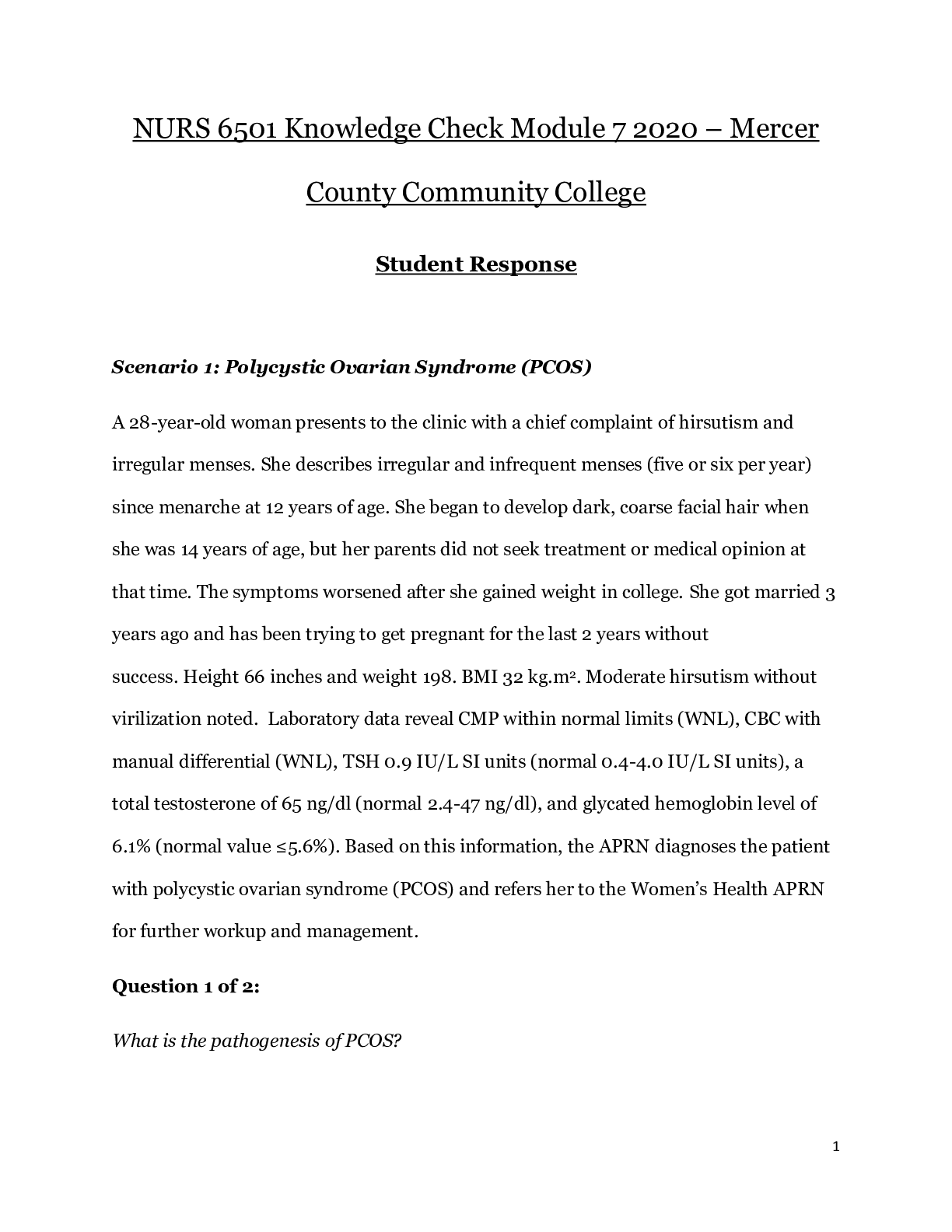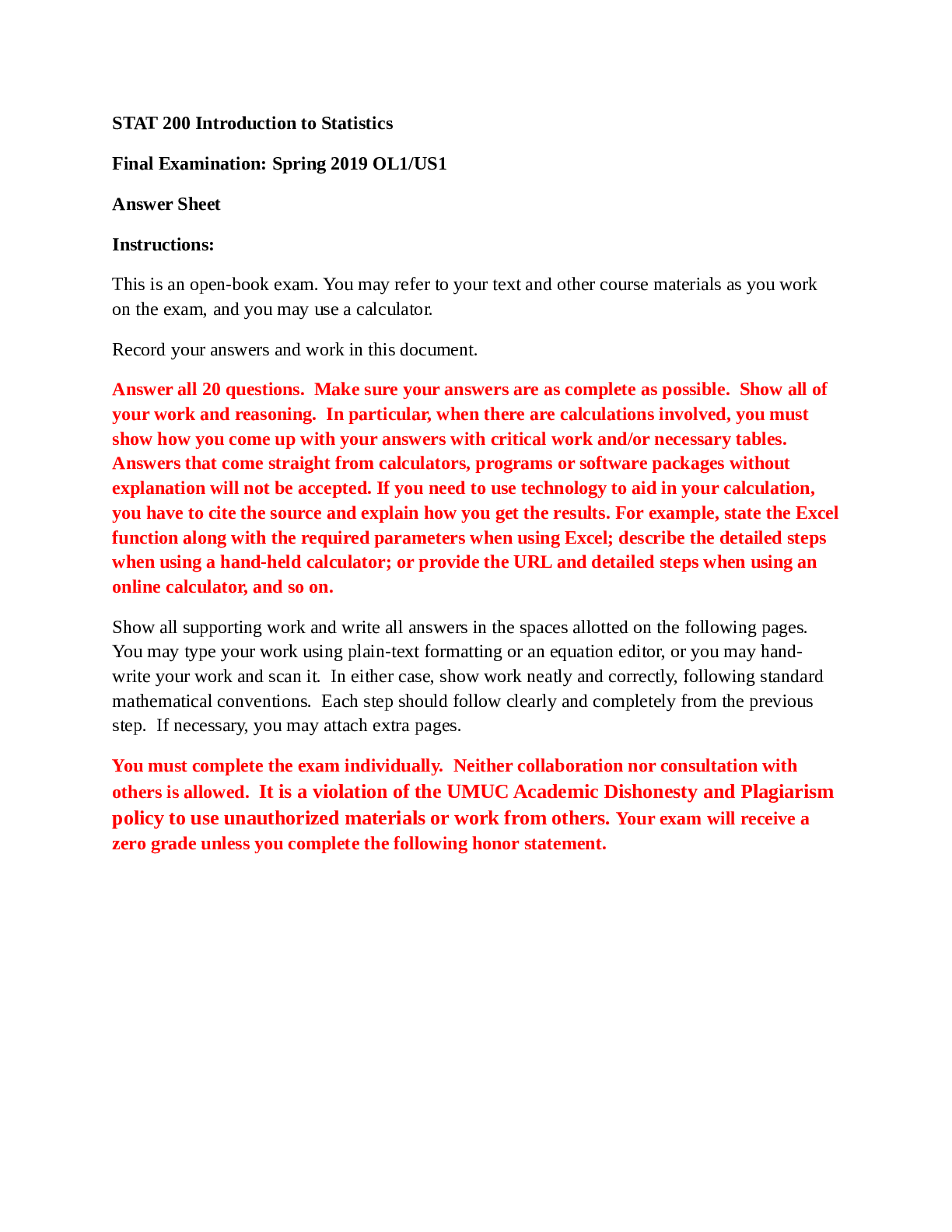*NURSING > EXAM > NURS 6501 Knowledge Check Module 5 2020 – Mercer County Community College | NURS6501 Knowledge Che (All)
NURS 6501 Knowledge Check Module 5 2020 – Mercer County Community College | NURS6501 Knowledge Check Module 5 2020
Document Content and Description Below
NURS 6501 Knowledge Check Module 5 2020 – Mercer County Community College Student Response Scenario 1: Gout A 52-year-old obese Caucasian male presents to the clinic with a 2-day history ... of fever, chills, and right great toe pain that has gotten worse. Patient states this is the first time that this has happened, and nothing has made it better and walking on his right foot makes it worse. He has tried acetaminophen, but it did not help. He took several ibuprofen tablets last night which did give him a bit of relief. Past medical history positive or hypertension treated with hydrochlorothiazide and kidney stones. Social history negative for tobacco use but admits to drinking “a fair amount of red wine” every week. General appearance: Ill appearing male who sits with his right foot elevated. Physical exam remarkable for a temp of 101.2, pulse 108, respirations 18 and BP 160/88. Right great toe (first metatarsal phalangeal [MTP]) noticeably swollen and red. Unable to palpate to assess range of motion due to extreme pain. CBC and Complete metabolic profile revealed WBC 14,000 mm3 and uric acid 8.9 mg/dl. The APRN diagnoses the patient with acute gout. 1 of 2 Questions: Describe the pathophysiology of gout. Gout is an inflammatory response to excessive quantities of uric acid in the blood and in other body fluids, including synovial fluid. Individuals with gout may have an accelerated rate of purine synthesis accompanied by an overproduction of uric acid. A deficiency of the enzyme HGPRT can lead to an increased production of uric acid. At the cellular level, purines are synthesized to purine nucleotides, which are used in the synthesis of nucleic acids, adenosine triphosphate, cAMP, and cGMP. Uric acid is a breakdown of product of purine nucleotides. 2 of 2 Questions: Explain why a patient with gout is more likely to develop renal calculi. Uric acid is mostly eliminated from the body through the renal system. Urate is filtered at the glomerulus and undergoes reabsorption and excretion within the proximal renal tubules. In primary gout, urate excretion by the kidneys is sluggish; due to a decrease in glomerular filtration of urate acid or acceleration in urate reabsorption leading to the development of renal calculi. Scenario 2: Lyme Disease Stan is a 45-year-old man who presents to the clinic complaining of intermittent fevers, joint pain, myalgias, and generalized fatigue. He noticed a rash several days ago that seemed to appear and disappear on different parts of his abdomen. He noticed the lesion below this morning and decided to come in for evaluation. He denies recent international travel and the only difference in his usual routine was clearing some underbrush from his back yard about a week ago. Past medical history non-contributory with exception of severe allergy to penicillin resulting in hives and difficulty breathing. Physical exam: Temp 101.1 ˚F, BP 128/72, pulse 102 and regular, respirations 18. Skin inspection revealed a 4-inch diameter bull’s eye type red rash over the left flank area. The APRN, based on history and physical exam, diagnoses the patient with Lyme Disease. She ordered appropriate labs to confirm diagnosis but felt it urgent to begin antibiotic therapy to prevent secondary complications. Question: What is Lyme disease and what patient factors may have increased his risk developing Lyme disease? Lyme disease is a multisystem inflammatory disease caused by the spirochete Borrelia burgdoferi transmitted by Ixodes tick bites and is the most frequently reported vector-borne illness. The risk factor that increased the risk of Lyme disease clearing underbrush from his backyard around a week ago. Working outdoors makes a person more at risk. The hallmark bull’s-eye rash commonly appears at the site of tick attachment. Scenario 3: Osteoporosis A 72-year-old female was walking her dog when the dog suddenly tried to chase a squirrel and pulled the woman down. She tried to break her fall by putting her hand out and she landed on her outstretched hand. She immediately felt severe pain in her right wrist and noticed her wrist looked deformed. Her neighbor saw the fall and brought the woman to the local Urgent Care Center for evaluation. Radiographs revealed a Colles' fracture (distal radius with dorsal displacement of fragments) as well as radiographic evidence of osteoporosis. A closed reduction of the fracture was successful, and she was placed in a posterior splint with ace bandage wrap and instructed to see an orthopedist for follow up. Question: What is osteoporosis and how does it develop? Osteoporosis or porous bone, is the most common bone disease in humans. It is characterized by low bone mineral density, impaired structural integrity of the bone, - - - - - - - - - - - - - - - -- -- -- - - - - -- The patient was diagnosed with a right middle cerebral artery vascular accident (CVA) secondary to atrial fibrillation (AF) Question: How does atrial fibrillation contribute to the development of a CVA? Atrial Fibrillation, puts patients at an increased risk for stroke because blood may not be properly pumped out of the heart, which may cause it to pool and form a clot. This clot can then travel to the brain and block the flow of blood to part of the brain which can result in a stroke. The most common site of occlusion is in the middle cerebral artery. Scenario 14: Osteoarthritis (OA) A 57-year-old male construction worker comes to the clinic with a chief complaint of pain in his right hip. The pain has progressively gotten worse over the last 2 months and he has been having trouble sleeping. There is little pain in the morning, but he is a bit stiff. The pain increases as the day wears on. has taken acetaminophen without any relief but states that the ibuprofen does work a little bit. He is anxious since the hip pain has limited his ability to work and he is afraid that his boss will fire him if he cannot perform his usual duties. There is no history of past trauma or infection in the joint. Past medical history noncontributory. Social history without history of alcohol, tobacco, or illicit drug use. Physical exam remarkable for decreased range of motion of the right hip. BMI 34 kg/m2. Radiographs in the office demonstrated asymmetrical joint space narrowing of the right hip with osteophyte formation. Several areas of the hip showed bone-on-bone contact with loss of the articular cartilage. The APRN tells the patient he has osteoarthritis (OA) and refers the patient to an orthopedist for evaluation of his need for a total hip replacement. Question: Describe how osteoarthritis develops and forms and distinguish primary osteoarthritis from secondary arthritis. Osteoarthritis is characterized by local areas of loss and damage of articular cartilage, new bone formation of joint margins, subchondral bone changes, variable degrees of mild synovitis, and thickening of the joint capsule. Primary OA also known as idiopathic OA often occurs without a known precipitating cause with aging. Secondary OA is caused by prior injury to the joint, and certain medications such as colchicine, indomethacin and steroids. Scenario 15: Fibromyalgia (FM) A 34-year-old Caucasian female presents to the clinic with a chief complaint of widespread pain in her joints and muscles. She states that her skin seems sensitive and sometimes it hurts to be touched. She has had extreme fatigue for the past 4 months. She admits to being depressed and it unable to sleep well. She has had to drop out of her gardening club due to pain. She says that bright lights and loud noises really bother her. Past medical history noncontributory. Social history is significant for her divorce from her husband 14 months ago. She is the mother of 2 small children and works as an administrative assistant as the local insurance company. Physical exam remarkable for tender points over her posterior supraspinatus muscles, occiput, trapezius, gluteal area, and sacroiliac joints bilaterally. The APRN tells the patient that she most likely has fibromyalgia, based on her physical exam. Question 1 of 2: What are the underlying causes of fibromyalgia? FM has unclear pathophysiology. Genetic factors are increasingly being suggested as important in developing FM. Aggregation of FM within families and other coexisting conditions such as IBS, chronic fatigue, and mood disorders, suggests a major role for neuroendocrine and stress-response alterations. Studies of genetic factors have implicated alterations in genes affecting serotonin, catecholamines, and dopamine., which are involved in the stress response and sensory processing. Question 2 of 2: The APRN tells the patient that the tender points are no longer used to diagnose FM. She suggests that the patient takes the Widespread Pain Index (WPI) and the Symptom Severity Inventory (SSI). The patient asks the APRN what these tests are for. What is the APRN’s best answer? These two tests are used to help diagnose FM. The Widespread Pain Index breaks the body down into 19 sections, each of which is considered a characteristic area of involvement for the last 1-week period. In System Severity Inventory, the individual is asked to rank specific symptoms of fatigue, waking unrefreshed, cognitive symptoms, and somatic symptoms on a scale of 0 to 3. The diagnosis of FM is then determined on the basis of both the WPI and SSI scores. [Show More]
Last updated: 2 years ago
Preview 1 out of 18 pages

Buy this document to get the full access instantly
Instant Download Access after purchase
Buy NowInstant download
We Accept:

Reviews( 0 )
$14.50
Can't find what you want? Try our AI powered Search
Document information
Connected school, study & course
About the document
Uploaded On
Nov 12, 2020
Number of pages
18
Written in
Additional information
This document has been written for:
Uploaded
Nov 12, 2020
Downloads
0
Views
77








 – University of the People.png)














